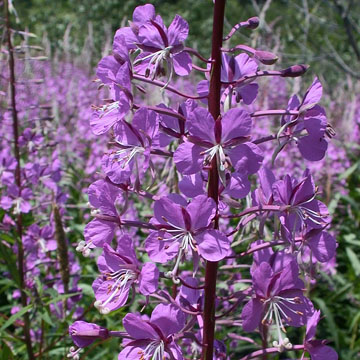

Chamaenerion angustifolium - (image 1 of 5)
Taxonomy
Family: Onagraceae
Synonymous with Epilobium angustifolium
Habitat
Highly adaptable, sometimes in gravelly or sandy soil but often on moist, rich soils. Usually in areas with little competition from other plants.
Associates
Distribution
Circumboreal, south to NJ, OH, northern IL, NE, and NM.
Morphology
Slender, monoecious, evergreen tree to 25 m; branchlets numerous from the axils of the lateral leaves, forming more or less flattened sprays; ultimate branchlets about 1 mm wide; leaves bluish-green, imbricate, scale-like, appressed, ovate, 2-4 mm, pointed, usually glandular, persisting and enlarging on the older branches; cones woody (fleshy when young), 6-8 mm, the scales mostly 6, pointed in the center; seeds winged.
Notes
Flowers June to September
Wetland indicator: FAC
Fireweed gets its name for its abundance after fire. Another common name is great willow herb. In the southern part of its range it tends to occur in populations of few plants but in the north it can form dense stands. The tetraploid ssp. circumvagum (Mosquin) Moldenke occurs in NY as opposed to the diploid ssp. angustifolium which is more northern.
References
Gleason, Henry A. and A. Cronquist. 1991. Manual of Vascular Plants of
Northeastern United States and Adjacent Canada. Second Ed.
The New York Botanical Garden. Bronx, NY
|
© Michael Hough 2018 |